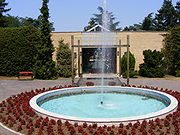
Museum of Yugoslav History
Encyclopedia


Serbia
Serbia , officially the Republic of Serbia , is a landlocked country located at the crossroads of Central and Southeast Europe, covering the southern part of the Carpathian basin and the central part of the Balkans...
, located in the Dedinje
Dedinje
Dedinje is an urban neighborhood of Belgrade, the capital of Serbia. It is located in Belgrade's municipality of Savski Venac...
district of Belgrade
Belgrade
Belgrade is the capital and largest city of Serbia. It is located at the confluence of the Sava and Danube rivers, where the Pannonian Plain meets the Balkans. According to official results of Census 2011, the city has a population of 1,639,121. It is one of the 15 largest cities in Europe...
.
The current museum (Muzej istorije Jugoslavije, formerly known as "Museum May 25th" and "Museum of the Revolution") was founded in 1996 as a successor to two previous institutions, the Tito Memorial Centre and the Museum of the Revolution of Yugoslav Nations and Ethnic Minorities. The museum complex comprises three buildings with a total surface of 5253 m², set in a a 3.2 hectare park:
- Museum "May 25th"
- House of FlowersHouse of Flowers (mausoleum)House of Flowers is the mausoleum of the leader of the Socialist Federal Republic of Yugoslavia, Josip Broz Tito, who died on May 4, 1980...
- Old Museum
The institution goes back to a centre that was established by Josip Broz Tito
Josip Broz Tito
Marshal Josip Broz Tito – 4 May 1980) was a Yugoslav revolutionary and statesman. While his presidency has been criticized as authoritarian, Tito was a popular public figure both in Yugoslavia and abroad, viewed as a unifying symbol for the nations of the Yugoslav federation...
during his lifetime. Much like the presidential libraries
Presidential library
In the United States, the Presidential library system is a nationwide network of 13 libraries administered by the Office of Presidential Libraries, which is part of the National Archives and Records Administration...
in the United States
United States
The United States of America is a federal constitutional republic comprising fifty states and a federal district...
, Tito's memorial centre was intended as a repository for preserving and making available the papers, records, collections and other historical materials relating to his life and work and the history of Yugoslavia
Yugoslavia
Yugoslavia refers to three political entities that existed successively on the western part of the Balkans during most of the 20th century....
.
After his death on 4 May 1980, Josip Broz Tito was buried in the House of Flowers
House of Flowers (mausoleum)
House of Flowers is the mausoleum of the leader of the Socialist Federal Republic of Yugoslavia, Josip Broz Tito, who died on May 4, 1980...
, set in the museum grounds. The museum has a collection of more than 200.000 items that illustrate the history of Yugoslavia throughout the 20th century, with the special accent on the life and work of Tito himself. It also keeps an extensive collection of the gifts Tito received during his many visits with foreign dignitaries during his presidency. The exhibits further include works of many world-notable artists, including original prints of Los Caprichos
Los Caprichos
Los Caprichos are a set of 80 aquatint prints created by the Spanish artist Francisco Jose de Goya in 1797 and 1798, and published as an album in 1799. The prints were an artistic experiment: a medium for Goya's condemnation of the universal follies and foolishness in the Spanish society in which...
by Francisco Goya
Francisco Goya
Francisco José de Goya y Lucientes was a Spanish romantic painter and printmaker regarded both as the last of the Old Masters and the first of the moderns. Goya was a court painter to the Spanish Crown, and through his works was both a commentator on and chronicler of his era...
, and many others.
For almost a decade after the breakup of the Socialist Federal Republic of Yugoslavia
Socialist Federal Republic of Yugoslavia
The Socialist Federal Republic of Yugoslavia was the Yugoslav state that existed from the abolition of the Yugoslav monarchy until it was dissolved in 1992 amid the Yugoslav Wars. It was a socialist state and a federation made up of six socialist republics: Bosnia and Herzegovina, Croatia,...
, the entire complex (the tomb and the museum) was closed to the public and the military guards were permanently removed. The complex is now again a major tourist attraction. Many people visit the place as a shrine
Shrine
A shrine is a holy or sacred place, which is dedicated to a specific deity, ancestor, hero, martyr, saint, daemon or similar figure of awe and respect, at which they are venerated or worshipped. Shrines often contain idols, relics, or other such objects associated with the figure being venerated....
to "better times", especially on 25 May (Josip Broz Tito's official birth date). The Government of Serbia
Government of Serbia
Officially the Government of the Republic of Serbia is the executive branch of government in Serbia.-Current government:The current government was elected on 7 July 2008 by the majority vote in the National Assembly of Serbia and restructured on 14 March 2011...
has planned to merge the museum into the Museum of the History of Serbia
National Museum of Serbia
The National Museum is the largest and oldest museum in Serbia. It is located in Republic Square, Belgrade, Serbia. The museum was established on May 10, 1844. Since it was founded, its collections have to over 400,000 objects including many foreign masterpieces...
.

